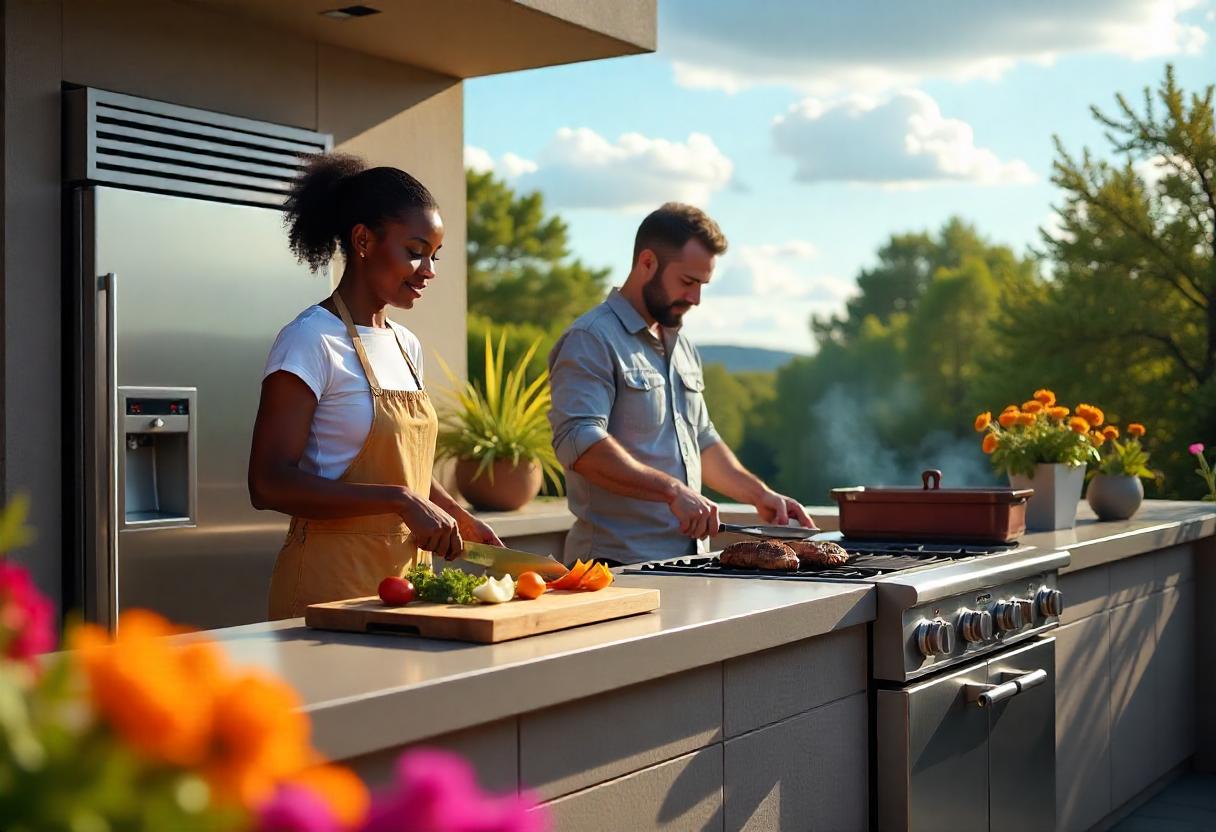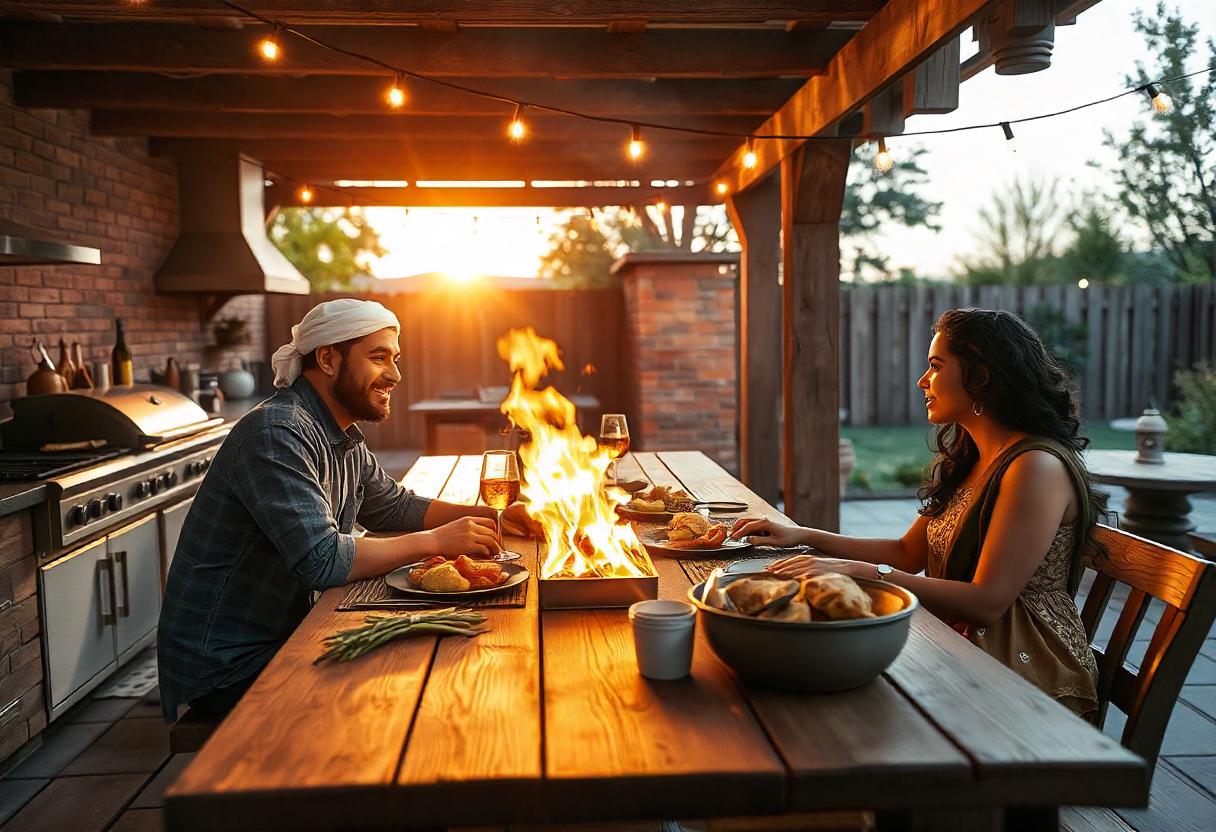The Ultimate Guide to Outdoor Kitchens
Introduction
In recent years, outdoor kitchens have emerged as a popular trend among homeowners seeking to enhance their outdoor living spaces. These culinary havens not only provide a functional area for cooking and entertaining but also add significant value to a property. For architects and families alike, understanding the intricacies of outdoor kitchen design is essential for creating a space that is both aesthetically pleasing and highly functional. This comprehensive guide will explore the various elements of outdoor kitchens, from design considerations to essential features, ensuring you have all the insights needed to craft the perfect outdoor culinary oasis.
What Is an Outdoor Kitchen?
An outdoor kitchen is a designated cooking area located outside the confines of a traditional indoor kitchen. These spaces can range from simple grill setups to fully equipped culinary stations featuring sinks, refrigerators, and even pizza ovens. Outdoor kitchens are designed to facilitate cooking and entertaining in an open-air environment, allowing families to enjoy meals in a natural setting.
Benefits of Outdoor Kitchens
1. Enhanced Living Space: Outdoor kitchens expand the usable area of your home, providing additional space for gatherings and family activities.
2. Increased Property Value: A well-designed outdoor kitchen can significantly boost your home’s market value, making it an attractive feature for potential buyers.
3. Culinary Experience: Cooking outdoors allows for a unique culinary experience, offering opportunities for grilling, smoking, and preparing meals in a relaxed atmosphere.
4. Social Interaction: An outdoor kitchen encourages socializing, allowing families and friends to gather while cooking and enjoying meals together.

Key Design Considerations for Outdoor Kitchens
When designing an outdoor kitchen, several critical factors must be taken into account to ensure functionality, aesthetics, and comfort.
1. Location
The first step in designing an outdoor kitchen is selecting the right location. Consider the following aspects:
• Proximity to the Indoor Kitchen: Ideally, your outdoor kitchen should be close to your indoor kitchen for convenience, especially when transporting food and supplies.
• Sunlight and Shade: Assess the sun exposure throughout the day. While sunlight can create a warm atmosphere, too much direct sunlight can make cooking uncomfortable. Incorporating shade structures like pergolas or awnings can help balance this.
• Wind Direction: Understanding prevailing wind patterns can help you position your outdoor kitchen to minimize smoke and odors from drifting into your home or neighboring properties.
2. Layout and Design
The layout of your outdoor kitchen should prioritize functionality while maintaining an inviting aesthetic. Here are some common layouts:
• L-Shaped Layout: This design provides ample counter space and allows for easy movement between cooking zones. It works well for smaller backyards.
• U-Shaped Layout: Ideal for larger spaces, this layout offers extensive counter space and can accommodate multiple cooking appliances.
• Island Layout: An island design creates a central hub for cooking and entertaining, making it easy to interact with guests while preparing meals.
3. Essential Features
An outdoor kitchen should be equipped with various features to enhance its usability. Here are some must-have elements:
a. Grilling Station
A high-quality grill is the centerpiece of any outdoor kitchen. Options range from gas grills to charcoal and wood-fired models. Choose a grill that suits your cooking style and preferences.
b. Counter Space
Ample counter space is essential for food preparation and serving. Consider using durable materials like granite or concrete that can withstand outdoor conditions.
c. Sink
Including a sink in your outdoor kitchen facilitates easy cleanup and food preparation. Opt for a stainless steel sink that is resistant to rust and corrosion.
d. Refrigeration
A compact refrigerator or beverage cooler can keep drinks and ingredients easily accessible during gatherings.
e. Storage Solutions
Incorporate cabinets or shelves to store utensils, cookware, and other essentials. Weather-resistant materials are crucial for longevity.
4. Utilities
Consider the necessary utilities for your outdoor kitchen:
• Electricity: Ensure there are enough outlets for appliances, lighting, and other electrical needs.
• Water Supply: Plan for plumbing if you intend to include a sink or refrigerator.
• Gas Lines: If using gas grills or appliances, consult with professionals to safely install gas lines.
Aesthetic Elements of Outdoor Kitchens
An outdoor kitchen should not only be functional but also visually appealing. Here are some design elements to consider:
1. Material Selection
Choose materials that complement your home’s architecture while being durable enough to withstand outdoor conditions:
• Countertops: Materials like granite, quartz, or concrete offer durability and style.
• Cabinets: Weather-resistant materials such as stainless steel or marine-grade polymer are ideal for outdoor cabinetry.
• Flooring: Options include stone pavers, tile, or composite decking that can handle the elements.
2. Lighting
Proper lighting enhances both functionality and ambiance in an outdoor kitchen. Consider incorporating:
• Task Lighting: Install lights above cooking areas to ensure visibility during meal preparation.
• Ambient Lighting: Use string lights or lanterns to create a cozy atmosphere for evening gatherings.
3. Landscaping
Integrate landscaping elements that enhance the overall design of your outdoor kitchen:
• Plants: Incorporate greenery or herbs that can be used in cooking.
• Hardscaping: Use stone walls or pathways to define the space and create visual interest.
Outdoor Kitchen Trends
Staying updated on current trends can help you design an outdoor kitchen that feels modern and inviting. Here are some notable trends:
1. Multi-functional Spaces
Outdoor kitchens are increasingly being designed as multi-functional spaces that incorporate dining areas, lounges, and even fire pits for year-round enjoyment.
2. Eco-Friendly Features
Sustainable designs are gaining popularity, with homeowners opting for energy-efficient appliances, solar lighting, and eco-friendly materials.
3. Smart Technology
The integration of smart technology into outdoor kitchens allows homeowners to control appliances remotely, monitor cooking temperatures, and enhance overall convenience.
Tips for Maintaining Your Outdoor Kitchen
To ensure your outdoor kitchen remains in top condition, follow these maintenance tips:
1. Regular Cleaning: Clean surfaces after each use to prevent buildup of grease and grime.
2. Weather Protection: Use covers for appliances when not in use to protect them from the elements.
3. Seasonal Maintenance: Perform seasonal check-ups on appliances, plumbing, and electrical systems to ensure everything is functioning properly.
Conclusion
An outdoor kitchen represents more than just a cooking area; it embodies a lifestyle centered around food, family, and nature. For architects and families alike, understanding the nuances of outdoor kitchen design is essential for creating a space that meets both functional needs and aesthetic desires. By considering location, layout, essential features, and aesthetic elements, you can craft an outdoor culinary oasis that enhances your living experience while adding value to your property.
As you embark on this journey of designing an outdoor kitchen, remember that it should reflect your personal style while being practical for everyday use. With careful planning and attention to detail, your outdoor kitchen can become the heart of your home—an inviting space where memories are made around delicious meals shared with loved ones.
—
This article serves as a comprehensive resource for architects and families looking to explore the world of outdoor kitchens. By focusing on key considerations and current trends, you can ensure that your outdoor culinary space is both functional and beautiful.
